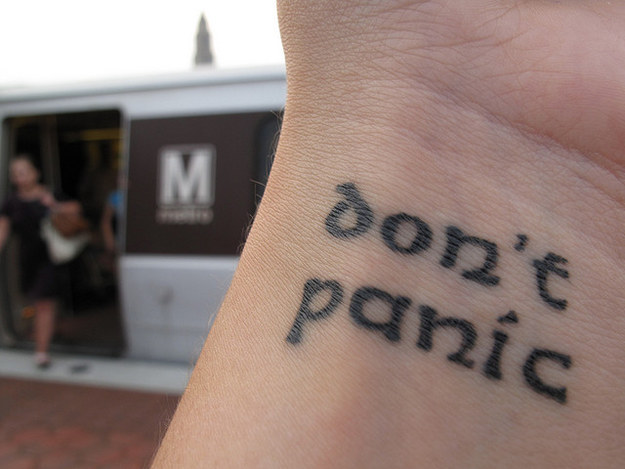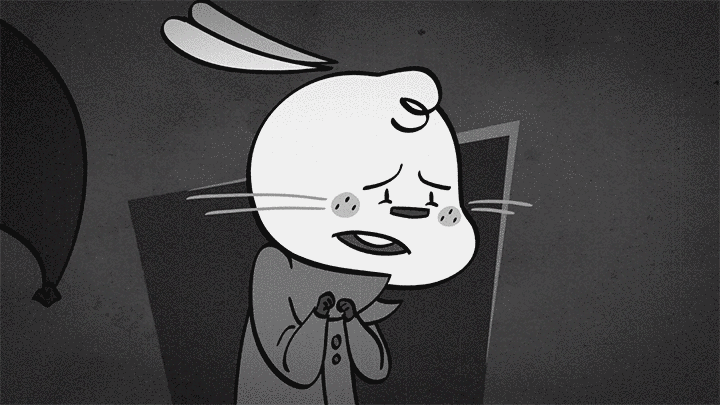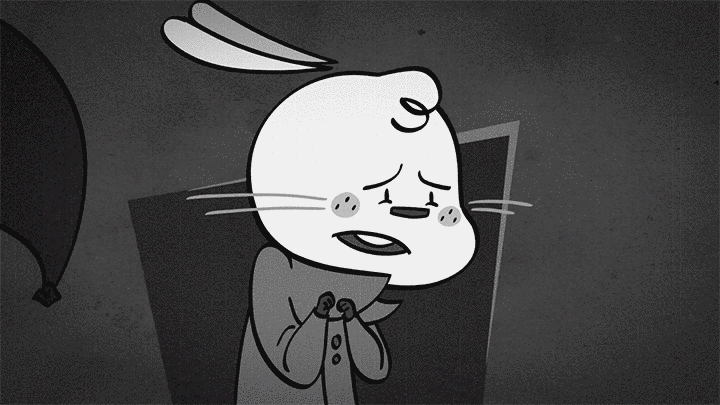Maybe you’re out for a walk, at work, on a date, or sitting at home watching Netflix, and for literally no reason at all, you suddenly feel that something is very wrong.

neilsanders.tumblr.com / Via giphy.com
You’re terrified, helpless, and sure that you’re dying. That’s what a panic attack feels like.
Anyone can have a panic attack.
They can strike anyone at any time — whether you have a history of anxiety or none at all. Sometimes the cause may be obvious (like if you were just fired, you’re in a stressful social situation and you have social anxiety, or you’re faced with something that terrifies you), but other times it seems completely random.
About six million people in America have panic disorder.
There’s a difference between having the occasional panic attack and having panic disorder, clinical psychologist Merav Gur, Ph.D., tells BuzzFeed Life. Panic disorder is characterized by recurrent panic attacks as well as significant worry in between those episodes that you’ll have a panic attack, which can interfere with your daily life. If you have recurrent panic attacks, you’ll likely fit the criteria for panic disorder. But even just one panic attack followed by severe distress and interference with your daily life can signal panic disorder, says Gur.
Some people are more likely to develop panic disorder than others.

nevermindtheend / Creative Commons / Via Flickr: nevermindtheend
It’s more common in women than in men, and it most often starts in early adulthood, says Gur. You may also have a genetic predisposition to develop panic disorder if you have a family member with it or another anxiety disorder, psychologist Reid Wilson, Ph.D., author of Don’t Panic: Taking Control of Anxiety Attacks, and director of the Anxiety Disorders Treatment Center, tells BuzzFeed Life.
How you deal with a panic attack may also affect whether or not you develop panic disorder, says Gur. Some people may have a single episode or two and that’s it, while others may experience extreme worry and fear after a panic attack, which can lead to full blown panic disorder.
The symptoms of a panic attack are crippling and very real.
Here are some of the most common symptoms: – Pounding heart, accelerated heart rate, or heart palpitations – Sweating – Shaking or trembling – Shortness of breath, trouble breathing, or feeling like you’re choking – Dizziness, feeling lightheaded or faint – Chest pain – Nausea or stomach pain – Chills or hot flashes. – Numbness or tingling, especially in your hands and feet – Fear of dying – Fear of losing control or going crazy
Some people also experience derealization (feelings of unreality) or depersonalization (feeling detached from yourself), but these are less common, says Gur. No one knows why some people experience some of these symptoms and not others, but it’s generally understood that a panic attack involves at least four of these. Symptoms come on abruptly and can last anywhere from a few seconds to a half an hour, though it’s usually about 10 minutes, says Wilson. That said, you may feel some residual symptoms for a while after it ends.
What you’re actually feeling during a panic attack is an exaggeration of the arousal of your sympathetic nervous system.
A panic attack is essentially your body kicking in its fight-or-flight response when there’s actually no real threat. So if you were face-to-face with a lion you’d be totally ready — but you’re not, you’re face-to-face with Neflix, so you’re like WHAT IS HAPPEN WHY IS MY HEART BEATING LIKE THIS AND MY LEFT HAND IS NUMB AND I’M 100% DYING. Totally legit reaction.


So what’s actually happening in your body to cause all this chaos? Wilson explains: First your brain picks up on some perceived threat, which might be something like a random scary thought that you’re not even conscious of or a weird heartbeat rhythm. Your thalamus brings that sensory information to your amygdala, which translates it as danger and triggers the arousal of your sympathetic nervous system, which gives off the fight-or-flight response. During this time, epinephrine (your body’s adrenaline) is secreted in your brain and body, which triggers symptoms like an increased heart rate, rapid breathing, sweating, a rise in blood pressure, dilating pupils, dry mouth, and others.
These are normal sympathetic responses — they would happen naturally if you were in a fight with a lion — but because you’re NOT faced with a lion, you start to panic and ascribe meaning to these symptoms to try to make sense of them, like you’re having a heart attack / having an allergic reaction / about to pass out / actually dying / etc. This fear and panic can cause other symptoms to kick in and may also trigger hyperventilation (which can add on symptoms like shaking, tingling, dizziness, trouble breathing, chest pain, etc.).
It’s totally common to see a handful of doctors or even go to the emergency room for a panic attack.
Obviously most of the symptoms of a panic attack can also be symptoms of other health problems — that’s what makes them so scary and why it’s so hard to accept that it’s a panic attack and not a heart attack or something else. So if you’re experiencing the above symptoms and it’s new and scary to you, absolutely see a doctor to rule out anything else.
Gur and Wilson agree that most of their patients come to them after already seeing several doctors or visiting the E.R. and not getting any answers. For many, it’s a long, frustrating process before they figure out they’re panic attacks. “It’s critically important to rule out all of those things, and it’s important in getting better. You’re going to have another fearful thought and you have to be able to say ‘This is a panic attack,’” says Wilson. “Because there’s no clue in the symptoms that this is a panic attack.”
Panic attacks seem like they come out of nowhere, but they don’t actually.
There’s always some sort of trigger, but it could be something so slight, like a passing thought that you aren’t even aware you had, Gur says. Or you might have a panic attack months after something stressful or traumatic happened (like some sort of loss, separation, or rejection), says Wilson. So even when it seems like a panic attack is totally random, it might be helpful to try to think (alone or with a psychologist) about any potential triggers.
You might even get panic attacks if you’re really in tune to your body.


carolinedirector.tumblr.com / Via giphy.com
Some people who are prone to anxiety are super attuned to their body sensations, and that alone can trigger a panic attack, says Gur. For instance, maybe you notice a weird heartbeat or trouble breathing or some blurred vision. Most people might not even pick up on it (or they’ll attribute it to their morning coffee or allergies or whatever), but others can pick up on these tiny body sensations and focus in on them, triggering the panic attack. Again, you may not even be aware of these triggers, so it still might seem like it comes out of nowhere.
For some people, the fear isn’t that you’re dying but that you’ll lose control or humiliate yourself.
One thing that most people don’t understand about panic attacks is how they can be so scary when people know they get them. Doesn’t the fact that you know you have panic disorder help you realize that it’s just a panic attack?
Well… it’s not that simple. “Oftentimes the fear is about losing control, embarrassing oneself in public, being trapped in an uncomfortable situation, etc.,” says Gur. So even if you know this is your anxiety talking, it’s still terrifying to feel like you’re not in control and that you can’t do anything to stop this. “That’s why when we treat panic, we have to treat not only management of the physical symptoms, but also letting go of maladaptive thoughts and of control,” she says.
Breathing exercises or mindfulness techniques might help you in the moment.
http://instagram.com/p/19ZObaSrNW
Simply telling someone to “breathe” during a panic attack isn’t really helpful, because incorrect breathing can just make it worse. What you want to do is diaphragmatic breathing, where your belly is actually expanding in and out (rather than your chest going up and down). “Imagine you have a balloon in your stomach,” says Gur. It’s also helpful to take longer to exhale than inhale (so you can try inhaling for three seconds, exhaling for four seconds).
Another helpful tactic is progressive muscle relaxation, which is essentially doing a full-body scan where you tighten and release each muscle group in your body. You can start at your head or your toes, and take turns tensing one muscle group for a few seconds, then relaxing them for about 30 seconds, then moving on to the next muscle group. Here’s a guided progressive muscle relaxation you can try.
But the most important thing is to accept what’s happening, acknowledge that it’ll be over soon, and wait it out.
Remind yourself that this is a panic attack and that what you’re feeling are normal panic symptoms. “Describe what they are so you can let them go,” says Gur. Instead of thinking OMG I need to make my heart stop beating so fast, just acknowledge that your heart is beating fast, that it’s a sympathetic nervous system response, and that it’ll pass soon.
“The first thing people tend to do is escape,” says Wilson. But the experts actually suggest trying to face that panic head on. “Just kind of hang out with it and try to quiet down your thoughts and take the hit of having these sensations. That’s the best way to start getting control of the panic attack without learning that you must escape.”
Panic disorder can cause you to make tiny lifestyle changes that might seem like no big deal, but they can actually make your panic worse.
The problem with escaping the situation whenever you have a panic attack is that it works… in the short term. After the panic subsides, you feel like it was a good decision to take yourself out of the situation, and you make an association between the panic and whatever else was going on (whether you were at the grocery store, watching a scary movie, on the train, digesting Indian food, whatever).
When you have panic disorder, you fear that you’ll have a panic attack again, and that causes you to avoid certain things that you associate with them. So maybe you start taking the bus instead of the train, or you sit on the aisle when you go to the movies, or you only go to the grocery store with a companion. You might tell yourself that these are just insignificant choices, but really “you’re avoiding putting yourself in situations in which you might potentially have panic and have to cope with it,” explains Gur.
“If you start avoiding things, modifying your day, turning down certain assignments at work, you know you’re giving in to the anxiety,” she says. “You might feel good and you don’t have panic because you’re not doing things that cause panic, but that actually is indicating that you’re sheltering yourself from the anxiety.” Instead of getting a handle on your panic, you’re actually giving it more power.
If you’re having panic attacks and significant worry between attacks (or you’re changing your behavior because of them), seek out a therapist who specializes in panic disorder or anxiety disorders.
Whether you’ve had one panic attack or 20, a psychologist can help you get a handle on your symptoms and triggers. If therapy seems scary or expensive, Wilson suggests starting with some self-help books or websites to learn more about them. Research shows that some people will actually get better just by educating themselves about the condition, he says. So even just reading something like this can help you to make some sense of it. A few good places to start would be the Anxiety and Depression Association of America, the American Psychological Association, or the National Institute of Mental Health.
Medication may help, but it’s the least effective treatment method when used alone.

jessicahtam / Creative Commons / Via Flickr: jessicatam
If you’re still suffering from panic attacks or panic disorder, a doctor or psychiatrist may suggest medication. Panic disorder is typically treated with SSRIs (selective serotonin reuptake inhibitors, also known as antidepressants), which you would take on a daily basis. In some cases, a doctor may prescribe benzodiazepines (like Xanax), which would be more of a fast-acting but temporary solution.
But here’s the thing: Research shows that medication alone is the least effective treatment for panic disorder, says Wilson. The more effective options are therapy — typically cognitive behavioral therapy (CBT) — or a combination of therapy and medication.
Panic disorder is the most treatable mental health disorder.
With the right treatment — whether that’s psychoeducation, CBT, mindfulness therapy, medication, or some combination of these — you can manage or completely eliminate your panic attacks, says Gur. Seriously, think about that for a second. Panic attacks and panic disorder are really freaking terrifying, but it’s encouraging to know that they can actually be very manageable, too. That’s not to say that you might never have a panic attack ever again, but your personal goal may be getting to a point where you can manage your symptoms, recognize when you’re having one, and not let the panic escalate.
“Panic disorder wants you to fall for the idea that something terrible is happening,” says Wilson. Arming yourself with education and mindfulness training ahead of time can be so helpful, but your treatment may be an ongoing process that gets easier with time.
Remember, you’re not broken or weird or weak.
“Many people who have panic disorder start to see themselves as very fragile,” says Gur. But adopting a “fragile” sense of self won’t be helpful when you’re trying to manage panic and crush those avoidant behaviors. “You’re not a fragile person,” she says. “You’re just experiencing things maybe more acutely than other people.”


















